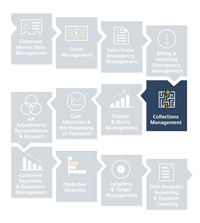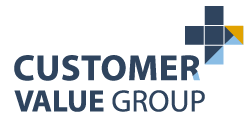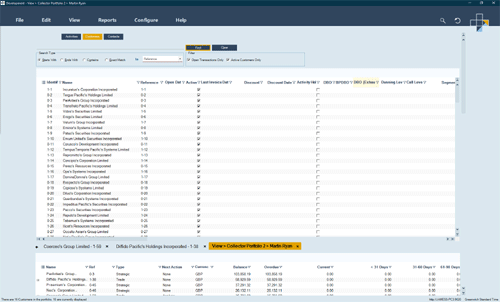COLLECTIONS MANAGEMENT

Automated Collections
Unified Global View
Unified single customer global view, including Customer portfolio activities, Credit risk performance, Dispute management process, Operational and Management reporting. All information is shown both numerically and graphically.
Customer Single View
The software provides a consolidated record for each customer account across all the source ERP systems within the organisation. This comprises all contacts and contact details, as well as financial information including ageing debt overview, credit limit, activity summary, comments and disputed invoices. Information available can also be filtered and exported in excel. Value+ has a Collector Porfolio. Collectors are assigned customers either in Value+ or through the source ERP systems and those customers show up within the Collector Portfolio. Value+ also has a Collector Dashboard where analytics about the customers that customer is managing can be seen.
Workflow Activities
Value+ has the ability to different types of activities and organising them in infinite amount of workflow structures – whether they be collection activities, queries, cash application activities, AR adjustment activities, internal activities (HR requests etc.), tagging activities (COVID-19 activities, etc.) It is also possible to create custom tasks for users to perform in a workflow. These can be:
- user tasks (which you want the user to perform )
- service tasks (which the system needs to do such as call an external service)
- script tasks (to kick off an automated script of actions)
- notification tasks (being informed of various actions to be taken)
- dispute activities (tagging part or all of various invoice(s) as being uncollectible)
- mail tasks (to configure emails to be sent to one or more recipients to inform them of a need to take action)
Customer Segments
Value+ has the ability to segment customers infinitely based on any kind of variables (Size, Sales, Turnover, Aged Debt, DBO, DSO, etc) requested by the customer. Collection rules determine the ‘valuation’ of customer:
e.g. risk class + total of open items due
since n days + broken promises to pay
= collection rule.
Each segment can have different kinds of strategies assigned to it, whether they be proactive-based, service-based or overdue-based strategies. A strategy is a sequence of activities organised in workflow. They can include actual activities, emails, dunning, notifications, statements, etc.
Customer Strategies
Strategies can be set up with varying levels of complexity for each customer type of status and segments. This can include automatic reminder letters, proactive calls, periodic statements, overdue calls and escalations. CVG can set up parameters (invoice value and invoice days due) which gives clients a priority list that will then create an item to be worked by a collector (worklist that the manager will assign to a collector) Activities assigned to collectors can be proactive actions (before the due date of the invoice), based on date (service strategies) or overdue (after the due date of the invoice). A work item can be created at invoice level or account level using our Parent-Child Consolidated Statement Functionality.
Comments
Detailed information is logged and date-stamped for each account and outcome of an event. User preferences allow the notes to appear on screen as soon as the account is accessed, and date search facility is also available.
Activity Configuration
Any number of activities can be configured based on customer segment. Customised configuration of workflow activities provide collection cycles for chasing debt. They can be defined by customer segment, type, age and value of an invoice, total debt of an account and by region.
Automated Tasks
Collector/Manager Automatic Tasks and Activities generation based on workflow process.
Diarised Call Lists
Customer call lists can be automatically generated from debt build templates and unfulfilled actions. Lists can be sorted by required action, age and size of debt.
Debt Ownership
Collection Ownership and implementation of Workflow Policies based on Customer Segment.
Automated Communication
Ability to automate communication both at customer level and at any internal operational and management function. This includes e-mails and other e-communication integration. – Furthermore, plain text messages can be created and mailed from the contacts, instalments, actions and query menus. Audio and paper attachments can be sent out in these communications.
Quick Search
A configurable search engine allows the account details relating to an incoming enquiry to be quickly located for reference. This can be done by transaction, territory, product, activity or any given data available linked to a customer. The engine can also be used to provide summary information across different types of accounts, debts or procedures. Can also be used as a means of instant reporting, and exported into whatever format required.
Instant letters, statements and faxes
Confirmation documents can be automatically generated when an action is agreed with a customer. The system will link and embed any third-party reporting tool and other document management systems. It can also interface with network fax software to provide instant fax transmissions, through an e-mail gateway.
Intelligent Dunning Cycle
Sophisticated automated Dunning letter cycle based on Customer Segment, Strategy and Workflow policies.
Call Back Actions
Reminders for call backs are set to trigger automatically, when an account is on a particular chase path, or can be entered manually by a collector. Actions and corresponding notes are written to the audit trail of the account.
Payment Promises
Promise Management activity workflow in order to monitor and report on cash promised and forecast future AR movements based on historical trends. A Promise action records the customer’s commitment to settle a debt by an agreed date. If the promise is not fulfilled, the account is placed on a collector’s call list for action. Promise actions can be logged against multiple items on an account.
Payment Plans
Ability to agree Customer Payment Plan and automated timing schedule. Fixed and variable payment plans can be administered by the system. Tolerance levels, defined for missed or incomplete payments, will automatically place the account on a collector’s call list. Value+ also has an activity to Authorise Payment plans. This can be auto-routed to the Collector Manager or Supervisor for approval prior to the collector creating the payment plan.
Escalation Procedures
Customer accounts are automatically referred to a manager or supervisor if time or action related criteria have not been met.
Invoice Listings
The system provides a number of display options for listing customer invoices. These include views of all invoices that qualify for chasing.
Invoice View and Search
Collectors can view a virtual image of the invoice they are chasing from the transaction window. A search facility is also available for viewing other current or archived invoices. Invoice line detail, and shipping Information can be viewed.
User Allocation Templates
Accounts can be automatically distributed to teams of individuals based on customer segment, customer profile, region or value of debt. Manual allocations can also be applied if required.
Collector Manager Functionality
The Collector Manager also has a Collector Management Portfolio and Collector Dashboard so that all collector’s performance and customers can be viewed. Value+ also has a Targeting module so that targets can be set at the collector level (ageing/cash collected…) and tracked versus performances.
Computer Telephony Integration
Value+ can integrate with telephony via two methods: Direct URI calls to trigger the default telephony application. Integration with a tool like Avaya calling directly to the Central Communications Toolkit. Value+ has a plugin system allowing for integration with third party tools.
Delegation Management
Credit managers or supervisors can redistribute collectors’ portfolio including the current day’s workload of an absent collector across other team members in a swift drag-and drop motion.
Workload Forecasting
Future activities can be collated to provide credit managers with collector’s workload projections for a particular date, month or range of dates.
Priorities
Users tasks can be given a priority, a set of custom attributes and a due date for example. An overall priority calculation for the whole Activity Portfolio can also be set. Value+ can set up parameters (invoice value and invoice days due) which gives Xerox a priority list that will then create an item to be worked by a collector (worklist that the manager will assign to a collector). This priority list is organised in an Activity Portfolio which is a worklist of all activities assigned to specific users/ teams etc.
We also enable Multi-edit for mass-editing of activities and a Scratchpad for bulk-creation of activities.

